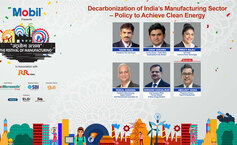
Lack of universal charging stations
Currently, there are multiple types of charging connectors used, making it difficult for EV startups to develop a universal charging solution that works across all EVs. This has led to a fragmented market, with each EV manufacturer developing its own charging infrastructure.
According to Hariyani, the immediate solution to the problem, is standardisation of EV charging connectors. "By adopting common standards for charging connectors, charging infrastructure providers can scale up their operations more efficiently and provide a more seamless charging experience for EV owners," he added.
"Several countries have already adopted standardisation for EV charging connectors, such as the CCS (Combined Charging System) and CHAdeMO (Charge De Move) standards in Europe, which has helped to create a more streamlined and efficient charging ecosystem," cited Hariyani. In India, "the government has proposed a common AC charging standard (Type 2) and a DC charging standard (CCS) to promote interoperability and compatibility between different types of charging stations," he added.
Talking about two wheelers (E2W) segment, Niranjan Nayak informed that the lack of standardisation in EV charging connectors, especially E2W, is a significant challenge for charging infrastructure providers in India. According to him, one of the biggest challenges that charging infrastructure providers face in India is the lack of interoperability. "The different types of charging connectors used by EV manufacturers make it difficult to create a universal charging solution that works across all EVs. This creates confusion for EV drivers and makes it difficult for charging infrastructure providers to attract and retain customers," states Nayak.
Lack of standardisation of E2W is another problem which is creating technical challenges for charging infrastructure providers in India. Elaborating on the challenge Nayak said, "Different charging connectors have different power ratings and charging speeds, making it challenging to design and deploy charging stations that are compatible with all E2W. This increases the complexity and cost of designing and manufacturing charging infrastructure and reduces its scalability."
To overcome these challenges, Nayak suggests that "India needs a national standard for EV charging connectors that is adopted by all EV manufacturers of the electric 2 wheelers. This would create interoperability and technical compatibility, reduce regulatory challenges, and create a more unified market for charging infrastructure providers in India. The government of India has taken steps, and it is hoped that a national standard will be adopted soon."
Tackling power grid constraints
Integrating many EVs charging simultaneously can strain the power grid, especially in areas with existing high electricity demand. Insufficient grid capacity and stability can result in voltage fluctuations, power outages, and other reliability issues, affecting the performance and availability of charging stations. The charging of EVs during peak demand periods can further stress the power grid.
Without appropriate management strategies, concentrated charging during peak hours can lead to increased strain on the grid and may require expensive grid upgrades to accommodate the additional load.
To address the grid-related challenges, Deswal suggests that a coordinated approach involving collaboration between government agencies, power utilities, and charging infrastructure providers is crucial. "Measures such as grid infrastructure upgrades, demand management strategies, incentivising off-peak charging, and integrating renewable energy can help mitigate the impact of power grid constraints and ensure a smooth and sustainable rollout of EV charging infrastructure in India," he added.
Kartikey Hariyani recommends implementing smart charging solutions that can help to manage the load on the power grid. "Smart charging solutions use advanced software and hardware to manage the charging process and optimise the use of available power. For example, these solutions can prioritise charging during off-peak hours when there is less demand for electricity, which can help to reduce the strain on the power grid."
Hariyani also suggested deploying renewable energy sources such as solar and wind power to generate electricity for EV charging infrastructure. "This can provide a reliable and sustainable source of electricity for EV charging, which can help to reduce the strain on the power grid," he added.
Apart from using renewable energy sources, Niranjan Nayak recommends that the government of India and private players need to work together to upgrade and modernise the power grid infrastructure. "This would involve investments in power generation and transmission infrastructure, as well as the adoption of smart grid technologies that can better manage power supply and demand."
He also recommended the deployment of energy storage solutions such as batteries, which can help mitigate the impact of power grid constraints on EV charging infrastructure. "Energy storage can help to balance the power supply and demand by storing excess energy during low demand periods and releasing it during peak demand periods," Nayak concluded.



























